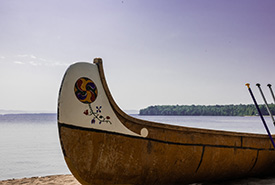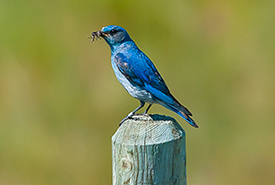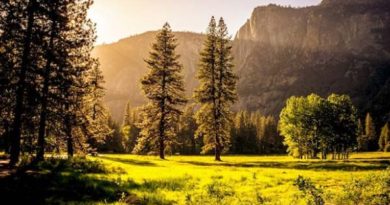NCC: Land Lines – Batchewana Island: Protecting paradise

The canoe on the beach, with Batchewana Island in the background. (Photo by Andrea J Moreau/NCC staff)
As a communications intern at the Nature Conservancy of Canada (NCC), I’ve spent a lot of time looking at photos of the many beautiful properties managed by NCC, carefully selecting the right shot to be included in a blog post or newsletter. This June, however, I had the opportunity to see a property not on my laptop screen, but through my camera lens.
I tagged along to an event celebrating NCC’s recent purchase of Batchewana Island, a place of serene shorelines, lush forests and flourishing wetlands in Lake Superior. Attendees boarded a nearly eight-metre-long canoe from the shores of Batchewana Bay, where the island was visible as a green mass in the distance. We paddled forward and as the shoreline came into focus, we all looked on in awe. Over 2,000 hectares of beautiful habitat made us and our canoe feel tiny by comparison.

A tree in the forest on Batchewana Island, ON. (Photo by Andrea J Moreau/NCC staff)
Largely undisturbed by human activity, stepping onto Batchewana Island felt a lot like travelling back in time. Prior to its protection by NCC, it was the largest remaining privately owned island on Lake Superior, and at imminent risk of development. In addition to providing habitat for several important species, Batchewana Island is a carbon sink; the carbon stored here is equivalent to the energy used by over 500,000 homes worth of carbon each year.
Situated on the lands of Batchewana First Nation, the island has been treasured for its beauty and rich biodiversity since time immemorial. The current that travels between the island and mainland was historically a hub for fishing due to its fast-moving water. The name Batchewana reflects this and comes from the Anishinaabemowin word badjiwanung, or “water that bubbles up.”

A green frog on the shore of Batchewana Island. (Photo by Andrea J Moreau/NCC staff)
In the short time I was on the island, I witnessed so much biodiversity, in large part due to enthusiastic attendees drawing my attention to plants, wildlife and animal tracks in the sand. Honestly, the sheer amount of movement on the island was a bit overwhelming — frogs hopped and butterflies fluttered away before I could snap (non-blurry) photos, and a deer swam past while my back was turned.
While I was able to photograph most of the species, people and landscapes I saw, there was one thing I wasn’t quite able to capture — the immense excitement and gratitude felt so deeply by all in attendance. Locals shared stories of visiting Batchewana Island growing up, and those who were not from these parts remarked on the island’s beauty.

Some of the attendees of the Batchewana Island supporter event on June 24th, 2023. (Photo by Andrea J Moreau/NCC staff)
One thing everyone had in common was a sense of relief that the island would be conserved. “It’s our backyard, but it’s also a major conservation victory for the whole watershed” shared one supporter. “It’s like our heart home and we’re especially grateful to have it conserved,” another exclaimed.
The wealth of stories and perspectives shared with me left me feeling incredibly moved and hopeful for the future. As we boarded the canoe to return to the mainland, I was overcome with a profound sense that I had just witnessed history being made.




